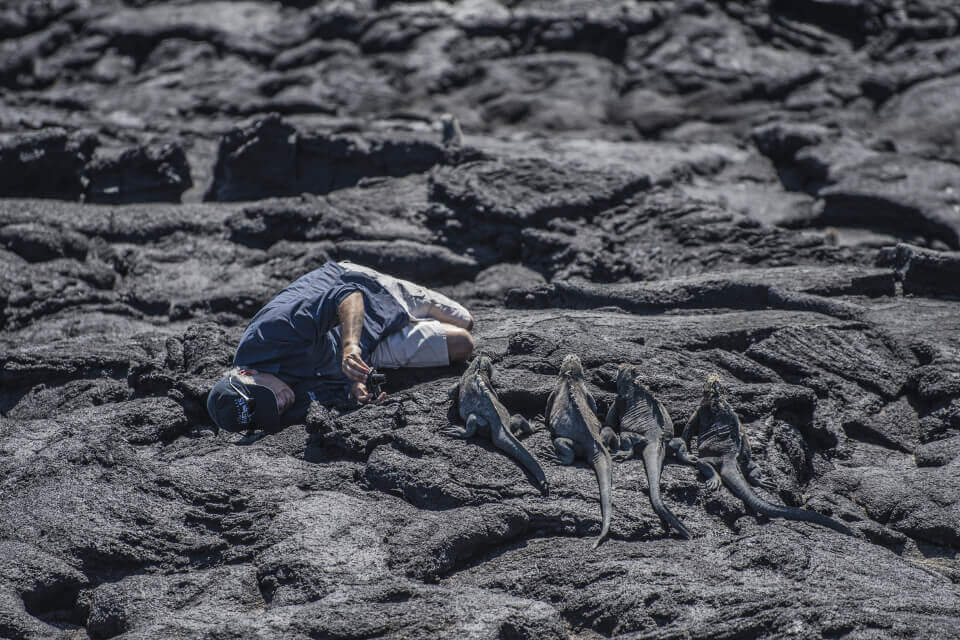All that matters during the Galapagos marine iguana mating season is the proper color at the right time and place. During the heating season, Marine Iguanas, one of our BIG15 emblematic species, exhibit a remarkable variety of visual and behavioral patterns! We encourage you to read their blog to learn how and why they do what they do!
TALK TO A DESTINATION EXPERT

Diego Zapata

Rosa Mena

Sandy Lara

Diego Zapata

Rosa Mena

Sandy Lara
IS THE SEASON FOR MARINE IGUANA MATING?
The breeding season for marine iguanas coincides with the onset of the hot season in the Galapagos, which runs from December to May. When you first look at it, you might think it strange that marine iguanas start their mating season at this very unusual time of year. Inconvenient, why? Mainly because rising water temperatures significantly decline the amount of nutrient-rich algae in the ocean, which is one of the marine iguanas’ primary food sources. This means that the mating season for marina iguanas starts at the exact moment when food supplies are at their lowest point ever. However, this is a component of their innate tactic, if you will.
However, marine iguanas are well-prepared for this challenging time. The truth is that during the dry season (Jun-Nov) when the waters of the Galapagos were practically bursting at the seams with algae, they stocked up massively. This implies that marina iguanas appear ridiculously plump if you happen upon them at this time of year. However, this is closely related to the behavior topic discussed in the next part.
SUNNY SEASON!
The start of the marine iguana breeding season coincides with the hot season for a more fundamental reason. The surroundings and weather are perfect for egg laying. Temperature and humidity are essential for the survival of their eggs. The hot season brings with it elevated levels of these two variables. Consequently, this marks the start of the marine iguana mating season, bringing about some interesting physiological changes.

The striking shade of teal that develops on the edge of the marine iguanas is the most noticeable of these physiological modifications. For example, their legs, face, and spine (Seen on Marine Iguanas on Española Island). This results in fantastic behavioral changes and a visual cue that the marine iguanas are ready to mate.
MALES VS. MALES & FEMALES VS. FEMALES Behavioral Patterns
This is when marine iguanas must use all the energy they store throughout the dry season. Male iguanas focus their energy on two main activities: chasing their tails and defending their territory. These innate tendencies show up as physical behaviors like head bobbing. A charge bobbing signal indicates to other animals that a creature is prepared for mating and territory defense.
In contrast, female iguanas use their saved energy to locate an excellent spot to lay their eggs. They expend much energy “probing” or testing several locations to find a perfect spot to lay their eggs. They make sure there is enough rubbish in the way of their nesting place and check for dampness. After locating the ideal nesting location, they excavate a hole roughly one foot (0.3 meters) deep, place their eggs inside, and then cover it. It’s important to remember that laying eggs also requires a significant energy expenditure. If needed, females will also protect and claim their nesting area.
The oval-shaped eggs have a delicate, leathery texture; they nearly seem squishy. This is an innate ability that promotes the growth of embryos. Water and moisture can enter through the porous layer that the shell forms, aiding in the embryo’s development.
CURRENT HEAT!
The mating process between marine iguanas must be violent. The female experiences excruciating agony during the insemination process. And it seems sense that they would be “reluctant” to engage in mating behavior. As a result, the male frequently has to grab the female and pin her down to prevent her from wriggling away from the act (and the agony). The female will lay her eggs around five weeks after this brief experience. She will lay six to eight eggs, eventually hatching into marine iguanas. Usually, hatching takes place in April or May of the following year. It was perfectly timed to coincide with the start of the dry season, just as upwellings replenish the algae that provide food for the marine iguanas’ progeny.
Are you curious to witness these fantastic behaviors when marine iguanas are breeding? Then make sure to board one of Yacht Isabela II’s many Galapagos tours to see them:
- Punta Espinosa (Fernandina Island) & Puerto Egas (James/Santiago Island)
- North Seymour Island
- Punta Suarez (Española Island)
Information & Photography provided by Francisco “Pancho” Dousdebés – Galapagos Expert

Javier Garcia

Eduardo Silva

Carolina Escobar
START PLANNING YOUR TRIP

Javier Garcia

Eduardo Silva

Carolina Escobar
Get in touch for more
CONTACT US







